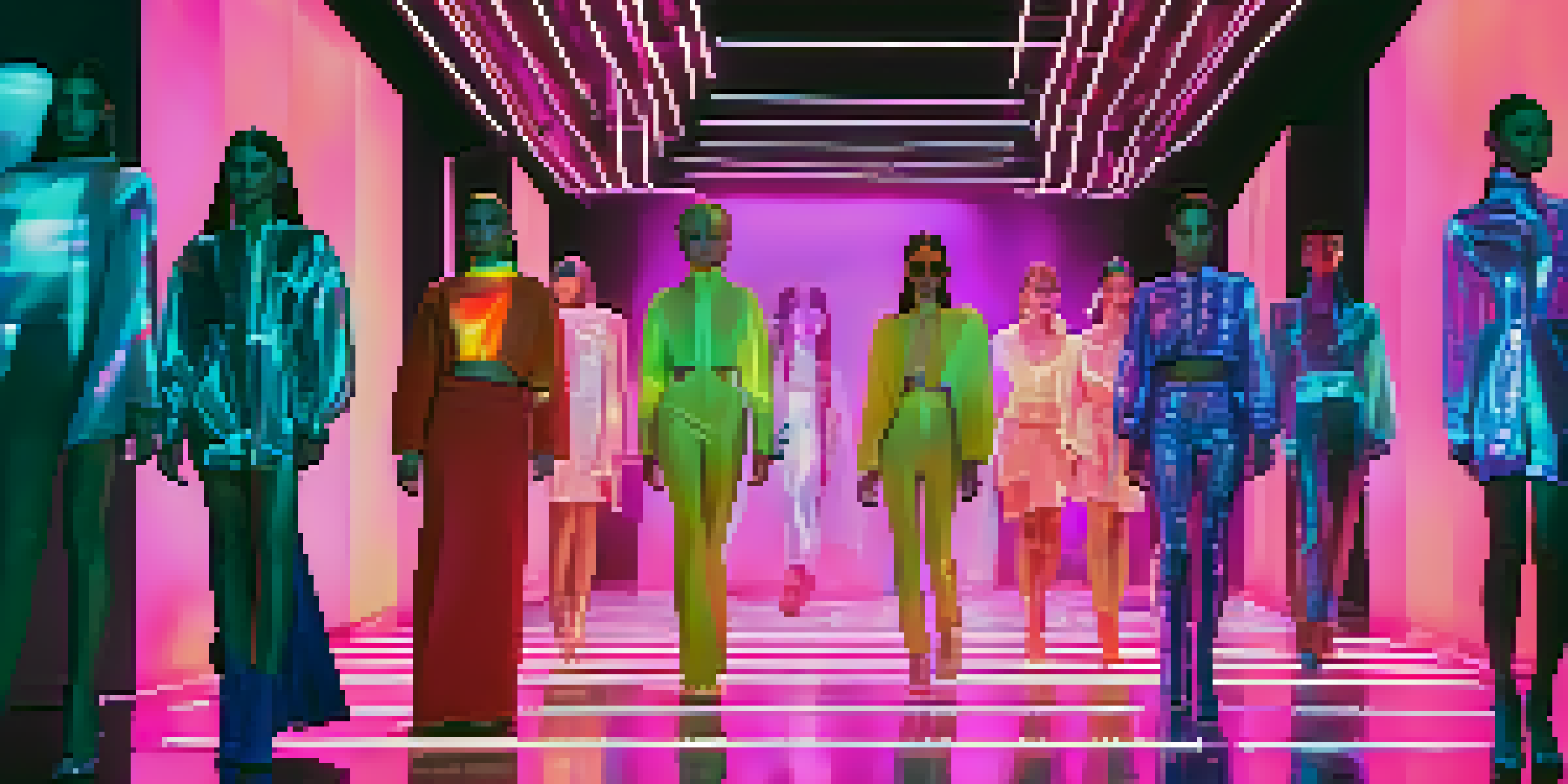Technology and Fashion: How Digital Shifts Affect Trends

The Rise of Digital Fashion in a Tech-Driven World
In recent years, digital fashion has emerged as a prominent trend, blending creativity with technology. Designers are now utilizing software to create virtual clothing that can be worn in digital environments, like video games and social media platforms. This shift not only expands the realm of fashion but also makes it more accessible to a wider audience who may not have the means to purchase high-end garments.
Fashion is the armor to survive the reality of everyday life.
Moreover, the concept of digital garments allows for sustainability, as it reduces the need for physical production. Imagine wearing a stunning dress in a virtual concert without any environmental impact—this is the future of fashion. As more brands experiment with this medium, we can expect an explosion of creativity that challenges traditional notions of how clothing is worn and appreciated.
These digital pieces also create new avenues for self-expression, as users can curate their online personas with unique, customized outfits that reflect their individuality. This evolution encourages a deeper connection between consumers and brands, leading to a more engaged community of fashion enthusiasts.
Social Media's Role in Shaping Fashion Trends
Social media platforms have become the modern runway, where trends can rise and fall overnight. Influencers and brands leverage platforms like Instagram and TikTok to showcase new collections, making styles go viral in a matter of hours. This rapid dissemination of trends changes how consumers shop and influences their purchasing decisions, often leading to impulse buys based on what's trending online.

Additionally, the interactive nature of social media allows consumers to participate in fashion conversations, sharing their outfits or styling tips with a global audience. This democratization of fashion means that anyone can become a trendsetter, breaking down barriers that once limited influence to a select few. It also fosters a sense of community among fashion lovers, where inspiration is just a click away.
Digital Fashion Meets Sustainability
The rise of digital fashion presents a sustainable alternative by reducing physical production and environmental impact.
However, the fast-paced nature of trends on social media can lead to a culture of disposability. As styles come and go, consumers may feel pressured to constantly refresh their wardrobes, raising questions about sustainability. Balancing the excitement of new trends with responsible consumption is an ongoing challenge in this digital age.
E-Commerce and the Changing Landscape of Shopping
The rise of e-commerce has transformed how we shop for fashion, offering convenience that traditional retail often cannot match. With just a few clicks, consumers can explore hundreds of brands, styles, and price points from the comfort of their homes. This shift has not only increased the accessibility of fashion but also changed how businesses strategize their marketing efforts.
The future of fashion is not just about clothes; it's about the experience and how technology can enhance it.
Moreover, augmented reality (AR) technologies are enhancing the online shopping experience. Imagine trying on clothes virtually before making a purchase, which reduces the chances of returns and boosts customer satisfaction. This technology is becoming increasingly common, helping consumers make informed decisions while also engaging them in a fun, interactive way.
As e-commerce continues to evolve, so does the emphasis on personalized shopping experiences. Brands are leveraging data analytics to track consumer behavior and tailor recommendations, creating a more individualized shopping journey. This blend of technology and fashion fosters loyalty, encouraging customers to return for a unique experience each time.
Sustainability in Fashion: A Digital Perspective
Sustainability has become a buzzword in recent years, and technology plays a crucial role in promoting eco-friendly fashion practices. Digital innovations, such as 3D printing and blockchain, are enabling brands to create more sustainable production processes. For example, 3D printing reduces waste by using only the necessary materials, while blockchain technology ensures transparency in sourcing and labor practices.
Additionally, online platforms are allowing consumers to make more informed choices when it comes to their fashion purchases. Websites that rate brands on sustainability practices or provide insights into the environmental impact of materials help shoppers align their values with their purchases. As consumers become more conscientious, brands are compelled to adapt and prioritize eco-friendly initiatives.
Social Media Fuels Fashion Trends
Social media platforms have transformed how trends emerge and spread, allowing anyone to become a fashion influencer.
The marriage of technology and sustainability is not just a trend; it's a necessity for the future of fashion. As we move forward, we can expect to see more collaborations between tech companies and fashion brands, driving innovative solutions that benefit both the planet and consumers.
The Influence of AI on Fashion Design and Trends
Artificial intelligence (AI) is revolutionizing the fashion industry, impacting everything from design to trend forecasting. Designers are now using AI algorithms to analyze consumer data, predicting what styles will resonate with audiences long before they hit the market. This predictive capability allows brands to stay ahead of the curve, ensuring they meet consumer demand with precision.
Moreover, AI tools can assist in the design process, generating unique patterns and styles that human designers can then refine. This collaboration between man and machine fosters creativity while streamlining the production process, ultimately leading to more innovative clothing lines. As AI continues to evolve, it will likely play an even larger role in shaping the future of fashion.
However, the rise of AI in fashion also raises questions about authenticity and creativity. As machines begin to influence design decisions, what happens to the unique human touch that has defined fashion for centuries? Striking a balance between technological advancement and the artistry of fashion will be crucial in this new era.
The Role of Virtual Reality in Fashion Experiences
Virtual reality (VR) is creating immersive experiences that are reshaping how consumers engage with fashion. Fashion shows, once limited to a select audience, can now be experienced by anyone with a VR headset, breaking down barriers and democratizing access to high-fashion events. This shift allows brands to reach a global audience, showcasing their collections in a captivating way.
Additionally, VR technology enables consumers to experience products in a lifelike environment before making a purchase. Imagine wandering through a virtual boutique, examining garments up close and interacting with them in a way that feels almost tangible. This level of interaction enhances the shopping experience, making it more engaging and enjoyable.
E-Commerce Enhances Shopping Experience
E-commerce and technologies like augmented reality are revolutionizing the shopping experience, making it more personalized and interactive.
As VR technology continues to mature, we can expect even more innovative applications within the fashion industry. From virtual fitting rooms to fully immersive fashion shows, the possibilities are endless, promising a future where technology and fashion coexist harmoniously.
The Future of Fashion: Blending Technology and Creativity
As technology continues to advance, the future of fashion is poised to be a fascinating blend of innovation and creativity. Designers are becoming more experimental, leveraging digital tools to push the boundaries of traditional fashion. The lines between physical and digital fashion are blurring, paving the way for new forms of expression and artistry.
Furthermore, as consumers become more tech-savvy, their expectations for fashion experiences will evolve. Brands will need to adapt to these changing demands, offering personalized, interactive encounters that resonate with their audience. This shift towards a more experiential approach will redefine how we perceive and interact with fashion.

Ultimately, the intersection of technology and fashion will open up new avenues for creativity and sustainability. As we embrace this digital transformation, the fashion industry has the potential to thrive in ways we have yet to imagine, inspiring a new generation of designers and consumers alike.